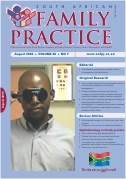updAIDS in SA Family Practice - Initiating anti-retroviral therapy in HIV-infected infants and children
Abstract
Highly active antiretroviral therapy (HAART) has brought about a dramatic reduction in the morbidity and mortality associated with human immunodeficiency virus (HIV) infection. With the availability of HAART, HIV has become a manageable chronic disease. Doctors may be intimidated by the prospect of managing HIV-infected children, but the basic principles of care are surprisingly simple. However, as HIV establishes latent reservoirs that are not eradicated with current treatment regimens, patients require life-long treatment and optimal patient management is crucial. The development of resistance (often related to poor adherence) limits future treatment options; therefore, careful preparation and continuous support are essential components of an optimal management plan. The principle underlying HAART is that antiretroviral drugs (ARV’s) from different classes are combined to achieve maximal and long term suppression of viral repli-cation, as it reduces the risk of random drug resistance. Achieving and maintaining a significant reduction in the viral load, preferably down to undetectable levels, is the main therapeutic aim. A significantly reduced viral load is required for immune recovery and clinical improvement, while an undetectable viral load is the best safeguard against the acquisition of drug resistance.
Section
Regulars
By submitting manuscripts to SAFP, authors of original articles are assigning copyright to the South African Academy of Family Physicians. Copyright of review articles are assigned to the Publisher, Medpharm Publications (Pty) Ltd, unless otherwise specified. Authors may use their own work after publication without written permission, provided they acknowledge the original source. Individuals and academic institutions may freely copy and distribute articles published in SAFP for educational and research purposes without obtaining permission.

